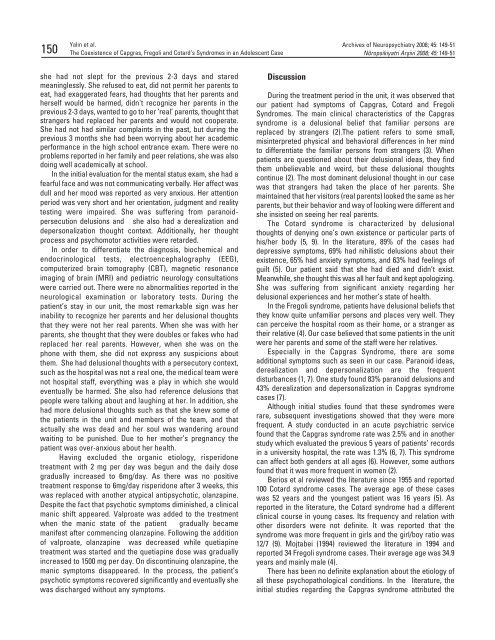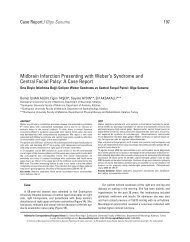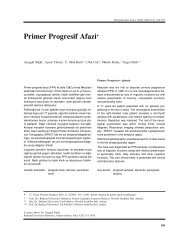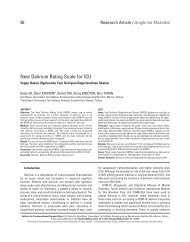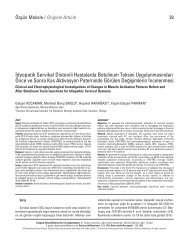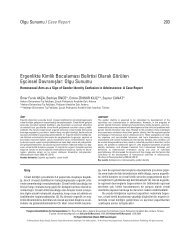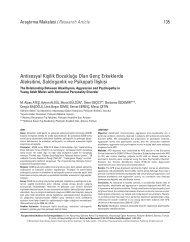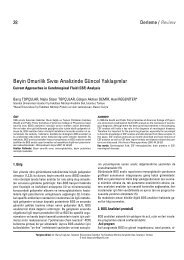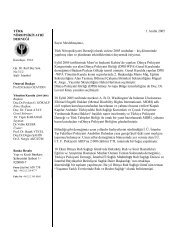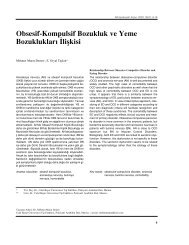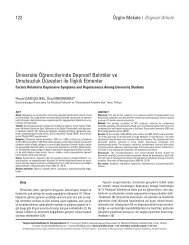The Coexistence of Capgras, Fregoli and Cotard's Syndromes in an ...
The Coexistence of Capgras, Fregoli and Cotard's Syndromes in an ...
The Coexistence of Capgras, Fregoli and Cotard's Syndromes in an ...
Create successful ePaper yourself
Turn your PDF publications into a flip-book with our unique Google optimized e-Paper software.
150Yal›n et al.<strong>The</strong> <strong>Coexistence</strong> <strong>of</strong> <strong>Capgras</strong>, <strong>Fregoli</strong> <strong><strong>an</strong>d</strong> Cotard’s <strong>Syndromes</strong> <strong>in</strong> <strong>an</strong> Adolescent CaseArchives <strong>of</strong> Neuropsychiatry 2008; 45: 149-51Nöropsikiyatri Arflivi 2008; 45: 149-51she had not slept for the previous 2-3 days <strong><strong>an</strong>d</strong> staredme<strong>an</strong><strong>in</strong>glessly. She refused to eat, did not permit her parents toeat, had exaggerated fears, had thoughts that her parents <strong><strong>an</strong>d</strong>herself would be harmed, didn't recognize her parents <strong>in</strong> theprevious 2-3 days, w<strong>an</strong>ted to go to her ‘real’ parents, thought thatstr<strong>an</strong>gers had replaced her parents <strong><strong>an</strong>d</strong> would not cooperate.She had not had similar compla<strong>in</strong>ts <strong>in</strong> the past, but dur<strong>in</strong>g theprevious 3 months she had been worry<strong>in</strong>g about her academicperform<strong>an</strong>ce <strong>in</strong> the high school entr<strong>an</strong>ce exam. <strong>The</strong>re were noproblems reported <strong>in</strong> her family <strong><strong>an</strong>d</strong> peer relations, she was alsodo<strong>in</strong>g well academically at school.In the <strong>in</strong>itial evaluation for the mental status exam, she had afearful face <strong><strong>an</strong>d</strong> was not communicat<strong>in</strong>g verbally. Her affect wasdull <strong><strong>an</strong>d</strong> her mood was reported as very <strong>an</strong>xious. Her attentionperiod was very short <strong><strong>an</strong>d</strong> her orientation, judgment <strong><strong>an</strong>d</strong> realitytest<strong>in</strong>g were impaired. She was suffer<strong>in</strong>g from par<strong>an</strong>oidpersecutiondelusions <strong><strong>an</strong>d</strong> she also had a derealization <strong><strong>an</strong>d</strong>depersonalization thought context. Additionally, her thoughtprocess <strong><strong>an</strong>d</strong> psychomotor activities were retarded.In order to differentiate the diagnosis, biochemical <strong><strong>an</strong>d</strong>endocr<strong>in</strong>ological tests, electroencephalography (EEG),computerized bra<strong>in</strong> tomography (CBT), magnetic reson<strong>an</strong>ceimag<strong>in</strong>g <strong>of</strong> bra<strong>in</strong> (MRI) <strong><strong>an</strong>d</strong> pediatric neurology consultationswere carried out. <strong>The</strong>re were no abnormalities reported <strong>in</strong> theneurological exam<strong>in</strong>ation or laboratory tests. Dur<strong>in</strong>g thepatient’s stay <strong>in</strong> our unit, the most remarkable sign was her<strong>in</strong>ability to recognize her parents <strong><strong>an</strong>d</strong> her delusional thoughtsthat they were not her real parents. When she was with herparents, she thought that they were doubles or fakes who hadreplaced her real parents. However, when she was on thephone with them, she did not express <strong>an</strong>y suspicions aboutthem. She had delusional thoughts with a persecutory context,such as the hospital was not a real one, the medical team werenot hospital staff, everyth<strong>in</strong>g was a play <strong>in</strong> which she wouldeventually be harmed. She also had reference delusions thatpeople were talk<strong>in</strong>g about <strong><strong>an</strong>d</strong> laugh<strong>in</strong>g at her. In addition, shehad more delusional thoughts such as that she knew some <strong>of</strong>the patients <strong>in</strong> the unit <strong><strong>an</strong>d</strong> members <strong>of</strong> the team, <strong><strong>an</strong>d</strong> thatactually she was dead <strong><strong>an</strong>d</strong> her soul was w<strong><strong>an</strong>d</strong>er<strong>in</strong>g aroundwait<strong>in</strong>g to be punished. Due to her mother’s pregn<strong>an</strong>cy thepatient was over-<strong>an</strong>xious about her health.Hav<strong>in</strong>g excluded the org<strong>an</strong>ic etiology, risperidonetreatment with 2 mg per day was begun <strong><strong>an</strong>d</strong> the daily dosegradually <strong>in</strong>creased to 6mg/day. As there was no positivetreatment response to 6mg/day risperidone after 3 weeks, thiswas replaced with <strong>an</strong>other atypical <strong>an</strong>tipsychotic, ol<strong>an</strong>zap<strong>in</strong>e.Despite the fact that psychotic symptoms dim<strong>in</strong>ished, a cl<strong>in</strong>icalm<strong>an</strong>ic shift appeared. Valproate was added to the treatmentwhen the m<strong>an</strong>ic state <strong>of</strong> the patient gradually becamem<strong>an</strong>ifest after commenc<strong>in</strong>g ol<strong>an</strong>zap<strong>in</strong>e. Follow<strong>in</strong>g the addition<strong>of</strong> valproate, ol<strong>an</strong>zap<strong>in</strong>e was decreased while quetiap<strong>in</strong>etreatment was started <strong><strong>an</strong>d</strong> the quetiap<strong>in</strong>e dose was gradually<strong>in</strong>creased to 1500 mg per day. On discont<strong>in</strong>u<strong>in</strong>g ol<strong>an</strong>zap<strong>in</strong>e, them<strong>an</strong>ic symptoms disappeared. In the process, the patient’spsychotic symptoms recovered signific<strong>an</strong>tly <strong><strong>an</strong>d</strong> eventually shewas discharged without <strong>an</strong>y symptoms.DiscussionDur<strong>in</strong>g the treatment period <strong>in</strong> the unit, it was observed thatour patient had symptoms <strong>of</strong> <strong>Capgras</strong>, Cotard <strong><strong>an</strong>d</strong> <strong>Fregoli</strong><strong>Syndromes</strong>. <strong>The</strong> ma<strong>in</strong> cl<strong>in</strong>ical characteristics <strong>of</strong> the <strong>Capgras</strong>syndrome is a delusional belief that familiar persons arereplaced by str<strong>an</strong>gers (2).<strong>The</strong> patient refers to some small,mis<strong>in</strong>terpreted physical <strong><strong>an</strong>d</strong> behavioral differences <strong>in</strong> her m<strong>in</strong>dto differentiate the familiar persons from str<strong>an</strong>gers (3). Whenpatients are questioned about their delusional ideas, they f<strong>in</strong>dthem unbelievable <strong><strong>an</strong>d</strong> weird, but these delusional thoughtscont<strong>in</strong>ue (2). <strong>The</strong> most dom<strong>in</strong><strong>an</strong>t delusional thought <strong>in</strong> our casewas that str<strong>an</strong>gers had taken the place <strong>of</strong> her parents. Shema<strong>in</strong>ta<strong>in</strong>ed that her visitors (real parents) looked the same as herparents, but their behavior <strong><strong>an</strong>d</strong> way <strong>of</strong> look<strong>in</strong>g were different <strong><strong>an</strong>d</strong>she <strong>in</strong>sisted on see<strong>in</strong>g her real parents.<strong>The</strong> Cotard syndrome is characterized by delusionalthoughts <strong>of</strong> deny<strong>in</strong>g one’s own existence or particular parts <strong>of</strong>his/her body (5, 9). In the literature, 89% <strong>of</strong> the cases haddepressive symptoms, 69% had nihilistic delusions about theirexistence, 65% had <strong>an</strong>xiety symptoms, <strong><strong>an</strong>d</strong> 63% had feel<strong>in</strong>gs <strong>of</strong>guilt (5). Our patient said that she had died <strong><strong>an</strong>d</strong> didn’t exist.Me<strong>an</strong>while, she thought this was all her fault <strong><strong>an</strong>d</strong> kept apologiz<strong>in</strong>g.She was suffer<strong>in</strong>g from signific<strong>an</strong>t <strong>an</strong>xiety regard<strong>in</strong>g herdelusional experiences <strong><strong>an</strong>d</strong> her mother’s state <strong>of</strong> health.In the <strong>Fregoli</strong> syndrome, patients have delusional beliefs thatthey know quite unfamiliar persons <strong><strong>an</strong>d</strong> places very well. <strong>The</strong>yc<strong>an</strong> perceive the hospital room as their home, or a str<strong>an</strong>ger astheir relative (4). Our case believed that some patients <strong>in</strong> the unitwere her parents <strong><strong>an</strong>d</strong> some <strong>of</strong> the staff were her relatives.Especially <strong>in</strong> the <strong>Capgras</strong> Syndrome, there are someadditional symptoms such as seen <strong>in</strong> our case. Par<strong>an</strong>oid ideas,derealization <strong><strong>an</strong>d</strong> depersonalization are the frequentdisturb<strong>an</strong>ces (1, 7). One study found 83% par<strong>an</strong>oid delusions <strong><strong>an</strong>d</strong>43% derealization <strong><strong>an</strong>d</strong> depersonalization <strong>in</strong> <strong>Capgras</strong> syndromecases (7).Although <strong>in</strong>itial studies found that these syndromes wererare, subsequent <strong>in</strong>vestigations showed that they were morefrequent. A study conducted <strong>in</strong> <strong>an</strong> acute psychiatric servicefound that the <strong>Capgras</strong> syndrome rate was 2.5% <strong><strong>an</strong>d</strong> <strong>in</strong> <strong>an</strong>otherstudy which evaluated the previous 5 years <strong>of</strong> patients’ records<strong>in</strong> a university hospital, the rate was 1.3% (6, 7). This syndromec<strong>an</strong> affect both genders at all ages (6). However, some authorsfound that it was more frequent <strong>in</strong> women (2).Berios et al reviewed the literature s<strong>in</strong>ce 1955 <strong><strong>an</strong>d</strong> reported100 Cotard syndrome cases. <strong>The</strong> average age <strong>of</strong> these caseswas 52 years <strong><strong>an</strong>d</strong> the youngest patient was 16 years (5). Asreported <strong>in</strong> the literature, the Cotard syndrome had a differentcl<strong>in</strong>ical course <strong>in</strong> young cases. Its frequency <strong><strong>an</strong>d</strong> relation withother disorders were not def<strong>in</strong>ite. It was reported that thesyndrome was more frequent <strong>in</strong> girls <strong><strong>an</strong>d</strong> the girl/boy ratio was12/7 (9). Mojtabei (1994) reviewed the literature <strong>in</strong> 1994 <strong><strong>an</strong>d</strong>reported 34 <strong>Fregoli</strong> syndrome cases. <strong>The</strong>ir average age was 34.9years <strong><strong>an</strong>d</strong> ma<strong>in</strong>ly male (4).<strong>The</strong>re has been no def<strong>in</strong>ite expl<strong>an</strong>ation about the etiology <strong>of</strong>all these psychopathological conditions. In the literature, the<strong>in</strong>itial studies regard<strong>in</strong>g the <strong>Capgras</strong> syndrome attributed the


